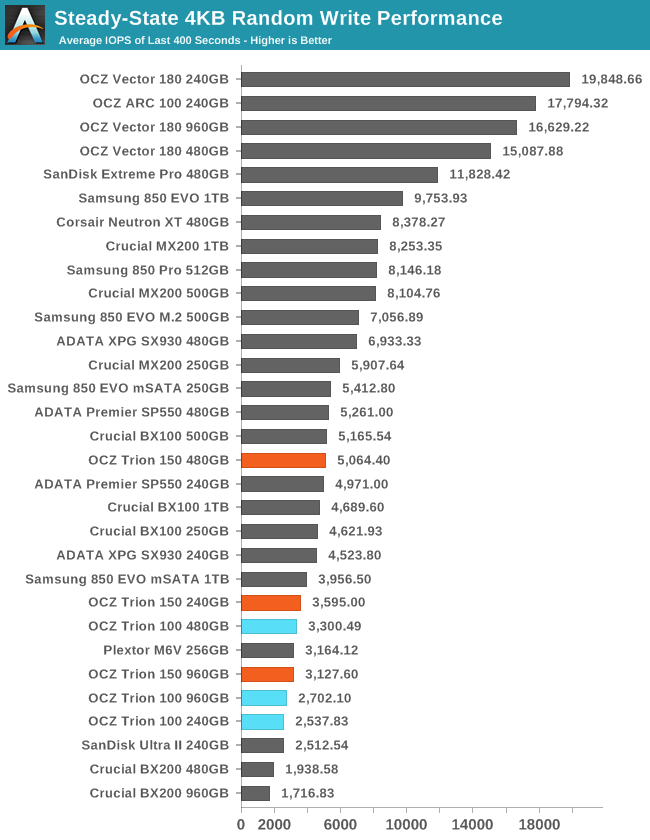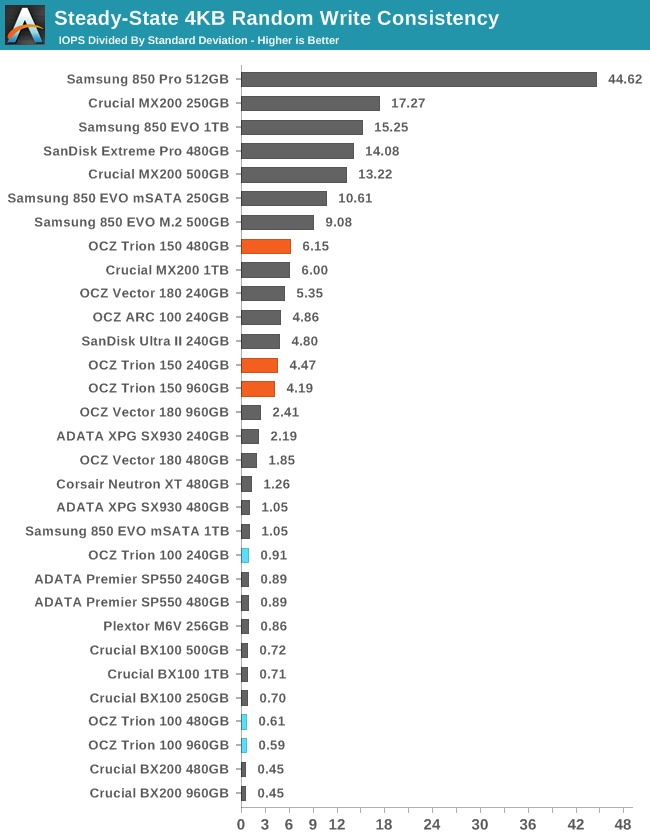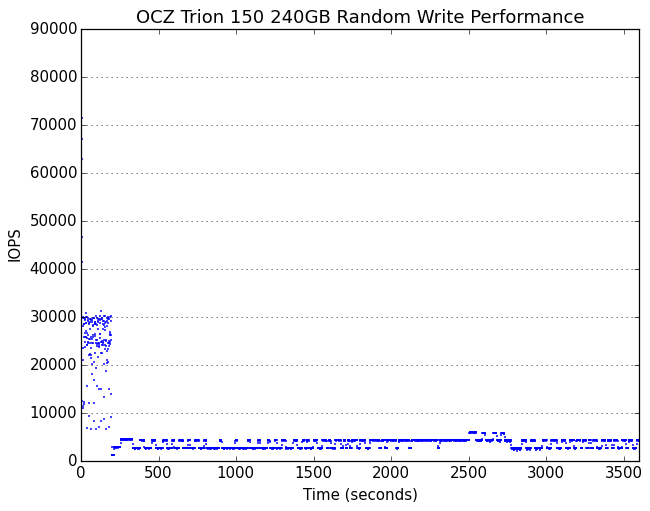The OCZ Trion 150 SSD Review
by Billy Tallis on April 1, 2016 8:00 AM ESTPerformance Consistency
Our performance consistency test explores the extent to which a drive can reliably sustain performance during a long-duration random write test. Specifications for consumer drives typically list peak performance numbers only attainable in ideal conditions. The performance in a worst-case scenario can be drastically different as over the course of a long test drives can run out of spare area, have to start performing garbage collection, and sometimes even reach power or thermal limits.
In addition to an overall decline in performance, a long test can show patterns in how performance varies on shorter timescales. Some drives will exhibit very little variance in performance from second to second, while others will show massive drops in performance during each garbage collection cycle but otherwise maintain good performance, and others show constantly wide variance. If a drive periodically slows to hard drive levels of performance, it may feel slow to use even if its overall average performance is very high.
To maximally stress the drive's controller and force it to perform garbage collection and wear leveling, this test conducts 4kB random writes with a queue depth of 32. The drive is filled before the start of the test, and the test duration is one hour. Any spare area will be exhausted early in the test and by the end of the hour even the largest drives with the most overprovisioning will have reached a steady state. We use the last 400 seconds of the test to score the drive both on steady-state average writes per second and on its performance divided by the standard deviation.

The Trion 150 substantially improves steady-state performance over its predecessor. The middle 480GB capacity is once again the best-performing size by a wide margin.

The Trion 150's consistency score has climbed out of the gutter—aided somewhat by the improved average performance, but there's clearly been a major change in behavior for the drive firmware that reduces the variability of write performance. The Trion 150 scores much better than any other budget drive.
 |
|||||||||
| Default | |||||||||
| 25% Over-Provisioning | |||||||||
After a very short initial burst of high performance due to SLC write caching, the Trion 150 settles into a pattern of decent but broadly variable performance as it burns through the remaining spare area. Once the spare area is exhausted the behavior changes completely and the drive is very steady, transitioning between a handful of discrete performance levels.
 |
|||||||||
| Default | |||||||||
| 25% Over-Provisioning | |||||||||
Looking closer at the steady-state phase, the transitions between performance states are very clear and abrupt, and there are no outliers in either direction. The performance with manual overprovisioning is substantially higher and the consistency is only slightly worse. In either case, the consistency is as good as we could ask for and a big improvement over the earlier Trion 100.










79 Comments
View All Comments
Arnulf - Friday, April 1, 2016 - link
So not only is this a low-end drive, it's an OCZ low-end drive.Thanks for the article and giving consumers heads-up so that we don't get burned!
Arnulf - Friday, April 1, 2016 - link
Ugh, EDIT function pretty please ...So not only is this a low-end drive, it's an overpriced OCZ low-end drive.
close - Friday, April 1, 2016 - link
I wouldn't call this a "burn" but it's definitely a warm beer after a hot summer day.LB-ID - Friday, April 1, 2016 - link
<Wanders in, sees another OCZ drive review><Reads the review, sees nothing has really changed>
<Wanders out to buy from a reputable brand>
Samus - Saturday, April 2, 2016 - link
I now feel like Toshiba is a Trojan horse, because all the OCZ drives that were in the buffer during bankruptcy and released after Toshiba initially bought them, in particular the exceptional ARC 100, were a sign they were turning things around.Then Toshiba releases this crap under the OCZ name. WTF are they thinking OCZ is a performance focused brand and these drives are clearly marketed at grandma's old Dell laptop.
xrror - Wednesday, April 6, 2016 - link
Yea but I think Toshiba's plan was to use OCZ for ALL of their customer facing drives. Before they bought OCZ they simply didn't offer retail drives at all!As far as a Toshiba Trojan horse... Toshiba actually had a competent drive itself right before it bought OCZ.
The Toshiba THNSNH drives were actually good (they don't bench awesome, but they're good) but since they were OEM only you've never heard of them. THNSNH was also a big jump from Toshiba's prior drives that seemed mostly made for industrial (performance wasn't great, but HDD wouldn't handle vibration/shock).
Bonus that Toshiba kept OCZ's in development models, so you had the ARC series come out. (vs. something ... not so nice like continuing Octane). But those were Marvell (I think) based with Indilinx firmware? Nothing wrong at all with that, but I imagine Toshiba's shareholders would question why they weren't using native Toshiba tech...
I'm actually really glad Toshiba of anyone (also, a surprise!) was able to snag the OCZ engineering team. Yea everyone loves to hate on OCZ, but OCZ really was the first company to so extremely aggressively bring SSD drives to the consumer market. Everyone likes to hate on Ryan Petersen but damnit, he really DID push to make SSD drives an affordable "thing" much MUCH sooner than just Intel alone would have.
They had a really rough time pounding out the bugs with SandForce yes... but seriously - who could have predicted that? (no, SERIOUSLY - before the kneejerk reaction, imagine being in OCZ's development shoes - that had to be really tough cause each time they thought they had it fixed, and it was always something very subtle). I always find it interesting that everyone forgets that their Indilinx controllers just worked - but they weren't the "sexy" fastest.
Saying that, I totally understand people who... after forking out their $600+ on a drive and having failure after RMA failure after "no this firmware really fixes it honest" failure upon failure would yea... swear off OCZ forever. But today's OCZ isn't that. Different time, place, era.
This comment has gone way too long. And I've lost my point lol.
And so you all don't think I'm a forgive and forget person. I'll never buy another Kingston product after the asshattery with the V300. When a company basically tells Anand himself to piss off when they bait and switch the NAND used...
http://www.anandtech.com/show/7763/an-update-to-ki...
Hey, at least Ryan Peterson and OCZ back then was super responsive to Anand directly when they got ripped a new one ;)
xrror - Wednesday, April 6, 2016 - link
Ugh, and I just realized I didn't address the part of using the OCZ name for non-performance parts.Basically, unless you're Samsung right now nobody is a performance part. And so that doesn't sound like a hipster "well, duh" answer - Samsung went crazy (awesome!) insane mad R&D into controllers and 3D NAND. Holy moly they even kicked Intel's butt enough so that Intel announces vaporware crosspoint memory.
I mean, halo effect in SATA market at least is crazy! SanDisk has some very extremely competitive models in their high end - but because they're maybe 3% slower in some benchmarks? Nobody on the street cares. That's nuts.
I dunno, I guess my point is that unless Toshiba/OCZ can somehow squeeze 12Gb/s through a SATA 3 link (I joke) they're not going to be able to market as a performance product these days.
Actually, the killer solution I think is to make an SSD controller that is both power efficient and makes TLC NAND not suck (so much). And that's not easy. At all. Cause small process planar TLC really a physics nightmare. I mean that's taking crappy flash drive memory and getting it to perform. Not easy.
leexgx - Sunday, April 24, 2016 - link
maybe i been unlucky i had to many sandisk SSDs (3) and SD (more than 5) cards fail (failing as what is in my phone right now about to funny enough change it for a 32GB EVO+)i do wish they would make more SSDs like the BX100 its the most power effect SSD i have ever seen (the BX200 and MX200 the very bad) BX100 is not very fast for a SSD but in laptops its very low power
jasonelmore - Saturday, April 2, 2016 - link
Still mad about that OCZ rebate scandal i see.Leyawiin - Sunday, April 3, 2016 - link
No, its a Toshiba low end. Do try and keep up.